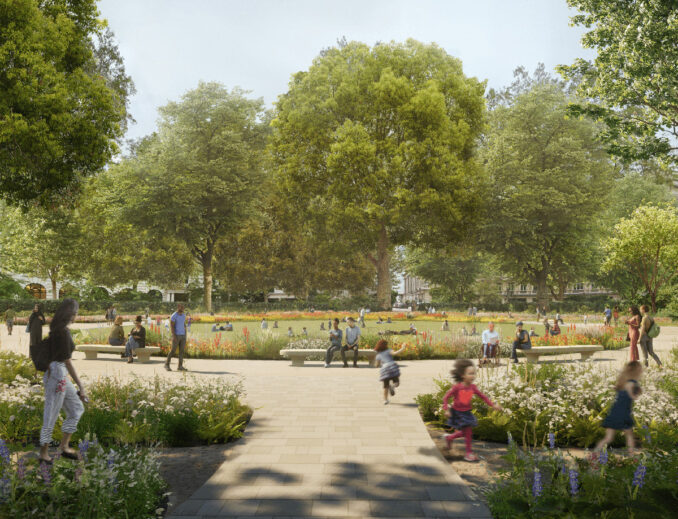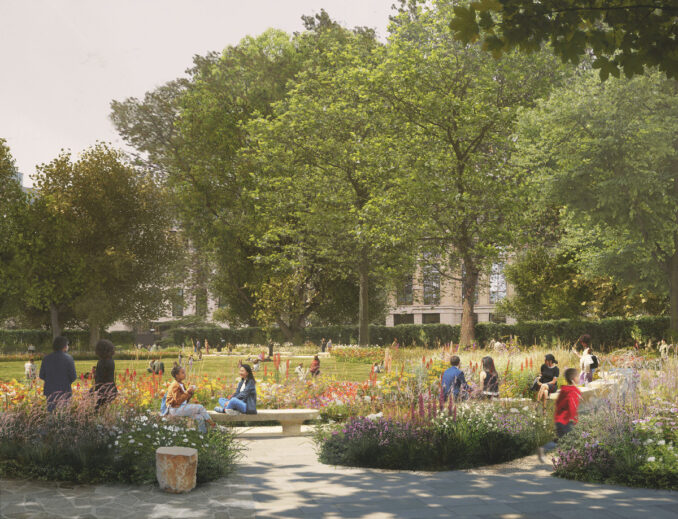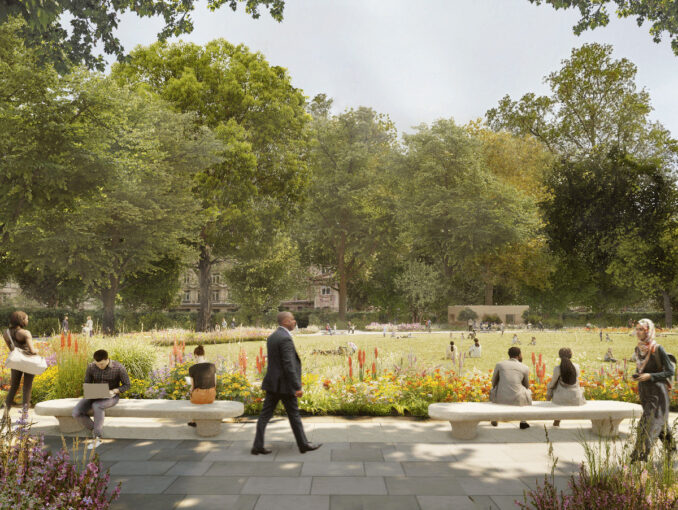The City of London Corporation has revealed new images showing how Finsbury Circus Gardens will look in the future. The project team includes the City of London Corporation, Realm, Studio Weave, Architecture 00, and maylim.
It comes as a project to transform the Grade II listed site, which is London’s oldest public park, gets underway.

The finished scheme at Finsbury Circus Gardens, which is due to complete later this year, will see improved seating, pathways, and new areas of planting around the central lawn, introducing a wide range of species and habitats for birds, bees, and bats.
Finsbury Circus Gardens is the largest green space within the City and just one of over 180 individual Square Mile sites, owned and managed by the City Corporation. They attract over 21 million visitors every year – which is over 230 times the capacity of London’s Wembley Stadium.
Finsbury Circus Gardens will be transformed into a tranquil haven for people to relax and spend time outside. Not only are City open spaces hugely important for people’s health and wellbeing, they also play a vital role by increasing the Square Mile’s resilience against climate change and enhancing biodiversity by creating habitats for a number of birds, butterflies, and insects.
Caroline Haines, Chair of the City of London Corporation’s Natural Environment Board.

The City of London Corporation wants to improve biodiversity within the Gardens. As a result, we will be introducing three new planting character areas, all with distinct plant palettes that reflect their different microclimates and provide new habitats. These are as follows:
Woodland Habitat
To the west of the Gardens, we are proposing to introduce a woodland habitat under the large canopies of the existing mature London Plane trees. This will include a number of shade-loving shrubs and evergreen plants with fragrant flowers around the gateways and adjacent to bench seats to enhance the visitor experience.
The planting will provide habitat for birds, in addition, we will also be looking to include loggeries for stag beetles and insects, bat boxes and nest boxes, helping to improve biodiversity in the area.
Riverside margin planting incorporating rain gardens
Riverside margin planting beds will reflect the Gardens’ historic relationship with the River Wallbrook. The beds in the south-eastern part of the Gardens will also function as specialised rain gardens with a sustainable drainage system (SuDS) to help mitigate the flow of surface water into the street drainage network and infiltrate the groundwater to support the trees and other planting.
Plants within this area have been selected for their ability to endure ground conditions that will vary between moist or poorly drained soil. In this area, there will be a high percentage of planting with seed heads for birds and pollinator species that will also provide visual interest for visitors.
Herbaceous Perennial Borders
Swathes of longer grass and spring bulbs around the lawn will provide colour and support for pollinators in spring. This will be followed through summer by a succession of flowering plants in the flower rich borders that edge the inner path and provide an attractive outlook from the new stone bench seats . Proposed species will be chosen from the RHS Perfect for Pollinators and Api: Cultural lists to help further improve biodiversity within the Gardens, including night-scented plants to attract moths and provide a food source for bats.

The flowers will create a palette of yellows, ochres, oranges, and dark reds around the central lawn.
Among them are 10 Sites of Importance for Nature Conservation in the City, designated for their importance for wildlife and for people to experience nature, and three sites featuring on the Historic England Register of Parks and Gardens of Specific Historic Interest in England, which identifies sites of historic significance.
Finsbury Circus Gardens
Project Team:
City of London Corporation
Realm – Landscape Architect
Studio Weave – Architect
Architecture 00 – Architect
maylim – Landscape Contractor
